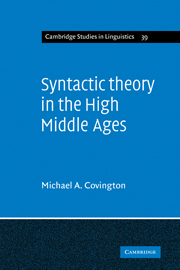Book contents
- Frontmatter
- Contents
- SOLI DEO GLORIA
- Preface
- 1 Introduction
- 2 Before the Modistae
- 3 Modistic grammar
- 4 Syntactic structure
- 5 Modistic treatments of particular syntactic problems
- 6 Subsequent developments
- Appendix: Notes on certain questions of authorship
- Notes
- Bibliography
- Index of names
- Index of topics
- Index of Greek terms
6 - Subsequent developments
Published online by Cambridge University Press: 04 August 2010
- Frontmatter
- Contents
- SOLI DEO GLORIA
- Preface
- 1 Introduction
- 2 Before the Modistae
- 3 Modistic grammar
- 4 Syntactic structure
- 5 Modistic treatments of particular syntactic problems
- 6 Subsequent developments
- Appendix: Notes on certain questions of authorship
- Notes
- Bibliography
- Index of names
- Index of topics
- Index of Greek terms
Summary
With Radulphus Brito and his contemporaries, modistic grammar had reached its apogee, and shortly afterward, metatheoretical objections brought its development to a halt. The objections came from Latin Averroists, such as Johannes Aurifaber (a follower of John of Jandun), and from nominalists such as Ockham. The Modistae, as moderate realists, had assumed that reality had a definite structure that was mirrored in cognition and in language; the objectors challenged this assumption, arguing that words were purely arbitrary representations of thoughts, and hence that the modistic theory of the cognitive and ontological basis of language was untenable.
The fall of modism
The debate over objections to modism seems to have broken out first, not at Paris, but at Erfurt, which by the early 1300s was the site of an intellectually active group of schools, even if not yet a university. Our first record of it comes from a public discussion presided over by Johannes Aurifaber in October of 1333 (or possibly 1332); an anonymous but detailed report survives and has been edited by Pinborg (1967:215-32). The nominal topic of the discussion is whether nominativo hie magister (‘in the nominative hie magister’)2 is a sentence. Aurifaber quickly gives the standard answer that it is if one supplies a verb – nominativo ‘hie magister’ ponitur or the like – and moves on ‘omissis aliis’ to the rather different issue of whether there are such things as modes of signifying.
- Type
- Chapter
- Information
- Syntactic Theory in the High Middle AgesModistic Models of Sentence Structure, pp. 120 - 132Publisher: Cambridge University PressPrint publication year: 1984



